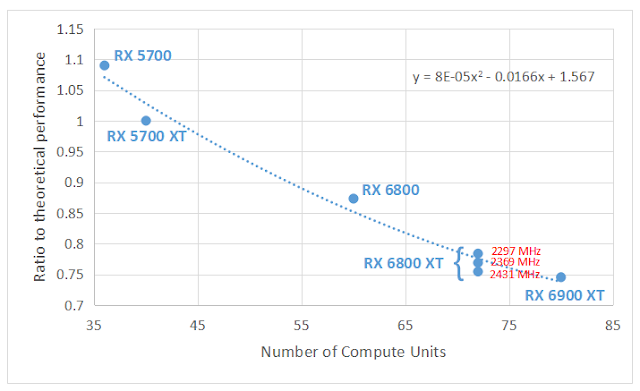 |
The RX 6900 XT reviews launched, the card launched and I have actual numbers to compare. So this is just going to be a quick update on the performance of this card within my previous analysis...
Shazam!
Once again, to remind everyone, I'm leaning on TechPowerUp's review for comparison between the stock RX 6800 XT and the stock RX 6900 XT. I will double check it with Eurogamer's/Digital Foundry's review if they have access to the card and post it.
Let's just get to the graphs:
 |
| The RX 6900 XT is perfectly in line with my previous comparison with RX 5700 XT performance-normalised per CU... |
Again, the RX 6900 XT data fits within my prior analysis showing that the compute unit performance per clock is not improved between RDNA 1 and RDNA 2.
 |
| The relative performance in games of the RX 6900 XT is even worse than the lower CU count cards... |
We can see the reason why AMD were not considering releasing the 80 CU variant of the RDNA 2 Navi 21 die because, aside from low yields, they will have trouble getting the performance out of the silicon. Again, as I said last time, going "wide" has its downsides and in the case of the RDNA architecture, it means that you can't feed the CU's as easily; it means you can't achieve the performance of a narrower architecture in game engines*. Of course, it's not a 1:1 ratio but the drop is clear from the curve of the graph - each CU in the RX 6900 XT is ~0.75x as efficiently utilised as a CU in the 40 CU RX 5700 XT.
*I expect the RX 6800/XT and RX 6900 XT to be more amazing for other applications just perhaps not gaming.
 |
| The RX 6900 XT lies below the RX 6800 XT - it has more cores asking for more from the supporting structures within the GPU architecture... |
This further confirms the prior work showing that there is a hard limit at 2.3 GHz for the RDNA 1 and RDNA 2 architectures. As they near that frequency, errors increase and an increase in performance per clock is possible but it becomes a war of attrition: more frequency = more errors = less relative performance gained = higher power usage.
You can see from the RX 6800 XT that the unit clocked at 2369 MHz is right on the trendline with the RX 5700 and RX 5700 XT (a 72 MHz difference), you only gain approximately 1-2 fps per game analysed. Whereas the jump from stock 2297 MHz to 2431 MHz (a 134 MHz difference) gained approximately 2-5 fps. That's a 0.04 fps gain per clock against stock for the 2431 MHz rated card and a 0.07 fps gain per clock against stock for the 2369 MHz card. That, right there, is the definition of diminishing returns!
This is exactly the thing Mark Cerny was talking about. (Yes, I know I keep trotting that quote out time and time again - it's just very pertinent to this discussion!)
The RDNA 1/2 architecture has a useful frequency limit of around 2.3 GHz and that cannot be broken. You can push the cards up to 3.0 GHz but you won't see linear scaling with frequency. You'll see even worse fps gains per clock than those relatively minor and with huge power draws, to boot!
Let's assume a 3.0 GHz clockspeed for the RX 6800 XT with the 0.03 fps increase per clock provided for Control's game engine by the 2431 MHz rated card (note that it would be worse than this but let's do it...). You would get around an additional 25 fps, bringing the performance from 97 fps to 122 fps at 1440p. That seems nice! However, your power budget would become enormous. I have no way of estimating that with the limited information I have on hand but the increase from 2297 MHz to 2431 MHz has Powercolor stating another 50 W board power compared to the reference design... for 134 MHz increase! If the power scaling was linear (Hint: it's not!) then you'd be drawing an extra 260 W for a total of 560 W board power.
It's no wonder that Jay from JayzTwoCents was not feeling the love for the RX 6900 XT. These cards are pushed as hard as they will go and it's not a surprise that AMD were considering not releasing the 80 CU card at all... (I can no longer Google results for this reference due to the RX 6900 XT release but the news articles are there to be found :) ).
No comments:
Post a Comment